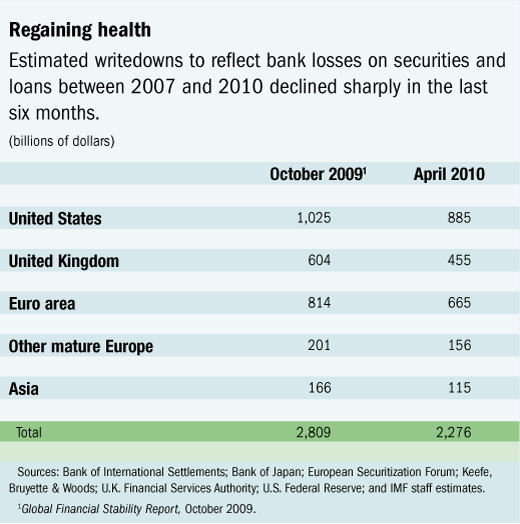
Typical street scene in Santa Ana, El Salvador. (Photo: iStock)
IMF Survey: Government Borrowing Is Rising Risk to World Financial System
April 20, 2010
- Projected losses shrinking among banks
- Government risk is new threat to prolonging financial crisis
- Credit recovery will be slow
The global financial system and the world economy are slowly regaining their health, thanks in large part to unprecedented interventions by governments, but the sharp rise in government debt during the economic crisis from already elevated levels helped create what the IMF says is the newest threat to the financial system: growing sovereign risk.

Halted building in Spain: Troubled banks often bid up rates to attract funds which can then squeeze margins for healthier banks (photo: Pascal Saez/Sipa Press)
GLOBAL FINANCIAL STABILITY REPORT
That is not to say that the private financial sector is fully recovered. Indeed, the recovery in the financial sector remains “fragile,” according to José Viñals, Financial Counselor and Director of the IMF’s Monetary and Capital Markets Department.
Bank balance sheets still contain bad assets, consumers and businesses remain stretched, and credit recovery is some time off, the IMF said in its latest Global Financial Stability Report (GFSR), released April 20. Moreover, a large part of the financial system continues to rely in varying degrees upon the extraordinary measures governments began to introduce two years ago—such as purchasing bad assets from, and injecting capital into, troubled institutions.
Heavy sovereign borrowing
But the biggest threats have moved from the private to the public sectors in advanced economies. Governments not only took on many of the bad assets from private institutions but due to the recession face continuing heavy borrowing needs for the next few years. Slow growth in the real economy and high unemployment will retard tax revenues and require higher government spending—such as on unemployment benefits and job creation activities.
“In spite of recent improvements in the outlook and the health of the global financial system, stability is not yet assured,” Viñals said a news conference April 20. “If the legacy of the present crisis and emerging sovereign risks are not addressed, we run the very real risk of undermining the recovery and extending the financial crisis into a new phase.”
In a wide-ranging assessment of the state of the global financial conditions, the IMF report said:
• Improving economic and financial conditions have helped private bank balance sheets in advanced economies. The IMF sharply reduced its estimate of the writedowns or loan loss provisions banks will have to take—or have taken—to account for bad loans and securities on their books. The improving quality of bank assets means that banks will probably need less capital than previously estimated to absorb losses. But banks still will face funding difficulties in the next few years, as their bonds mature and the special government assistance programs are withdrawn.
• Credit recovery will be “slow, shallow and uneven,” as heavy government borrowing soaks up available funds and banks continue their reluctance to lend to repair their balance sheets.
• There is little evidence, at least so far, of bubbles in asset prices in emerging markets, despite strong portfolio flows to Asian and Latin American countries from investors seeking higher returns.
• Authorities must address a number of policy issues, including how to manage borrowing and spending to minimize sovereign risk.
The IMF warned that the increase in sovereign risk can hit banking systems and the real economy that produces goods, services, and jobs. Even with weaker private credit demand, governments could crowd out business and household borrowers, retarding recovery.
Moreover, if jittery investors worried about long-run government solvency cause a decline sovereign bond prices in the advanced economies, still-recovering banks, which are major investors in government debt, could face new hits to the value of assets on their balance sheets. And rising interest rates on public debt could also flow through to the private sector raising borrowing costs for businesses, consumers, and banks.
Banks improve
This potential underscores the fragility of the recovery in the banking sector, which has shown great improvement since the last GFSR was issued by the IMF in October 2009.
The latest report said that the global banking system—which two years ago faced severe funding difficulties compounded by a lack of confidence among all market participants—is recovering. “Improving economic and financial market conditions have reduced expected writedowns and bank capital positions have improved substantially.”
The report cut its estimates of writedowns of bad loans and securities that banks—mostly in Europe, the United Kingdom, and the United States— will have to take during the period 2007 to 2010 from $2.8 trillion last October to $2.3 trillion (see table). Banks already have written off about $1.5 trillion of the $2.3 trillion, the IMF estimates.

Issues on the liability side of the ledger
Although the asset side of bank balance sheets is improving, the liability side may come under increasing pressure in coming months. It is clear that banks have improved their capital positions substantially, from private investors and increased earnings. And improvements in the asset picture mean less pressure on boosting capital buffers to absorb potential loan and security losses.
But authorities are likely to strengthen bank capital and liquidity requirements to increase the safety of the financial system. And banks must refinance nearly $5 trillion in debt that will mature in the next three years. “This will coincide with heavy government issuance and follow the removal of central bank emergency measures,” the report said.
Moreover, the overall picture masks some problem areas, the IMF said. There are problem pockets in regional banks with heavy real estate exposure in the United States; among Spanish banks, which are heavily exposed to real estate development loans; and in some regional banks in Germany. Troubled banks often bid up rates to attract funds which can then squeeze profit margins for healthier banks.
Credit recovery will be slow
Although the worst of the credit contraction may be over, banks are unlikely to boost lending substantially in the near term—both because of the continuing overhang of bad assets that remain on their books and the funding pressures they will face. Moreover the withdrawal of the special government support will further constrain bank lending.
Although private credit demand remains modest—households and businesses continue to reduce their debt levels—sovereign borrowing threatens to overwhelm it, potentially driving up interest rates, forcing private demand to shrink, or both.
No bubbles so far
A number of emerging markets and some advanced economies have become attractive opportunities for investors in most advanced economies, where returns are low and liquidity is high because of policies to support the financial sector and the real economy. Capital has flowed to countries such as Brazil, China, India, and Indonesia—as well as their trading and financial partners—which are perceived to have better cyclical and structural growth prospects.
Although these strong capital flows can create an environment conducive to strong increases in prices of assets such as real estate and equities, so far there is no evidence that these assets have been seriously and unsustainably overvalued, which could lead to the types of price bubbles that preceded the global crisis. Expansionary policies could fuel asset price inflation and the issue for policymakers is managing the consequences of these inflows. In an analytical chapter to the GFSR released April 13, the IMF explored the issues and policy options related to capital flows.
Policy implications
To keep the global financial system on its path to recovery, and manage the risks it faces, policy makers must consider a wide variety of issues.They include
• Carefully managing their budget deficits to ensure that they can sustain their fiscal policy over the medium term to avoid extending the crisis into a new phase.
• Ensuring a smooth deleveraging process that results in a vital and sound financial system that is of the right size, able to provide an adequate flow of credit to the private sector.
• Employing a wide range of tools, including macro-policy adjustments and prudential measures, to address the risks from strong portfolio inflows.
• Continue pushing for policies and regulatory reforms to improve capital and liquidity buffers, to enhance risk management, to reduce the likelihood and costs of the failure of a system institution, and to address the issue of too-important-to-fail institutions.


